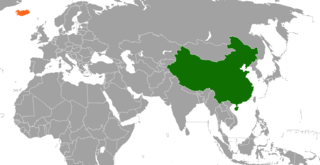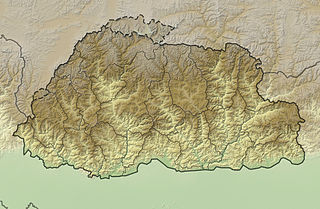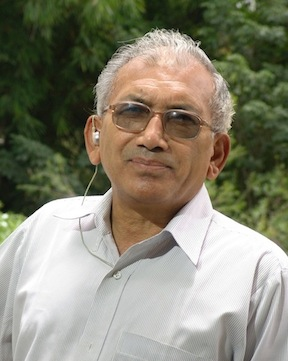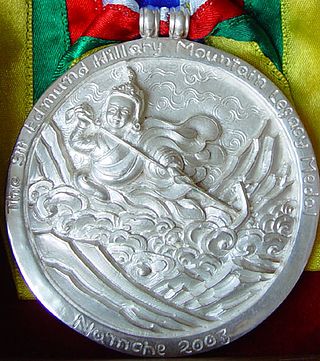
The Arctic fox, also known as the white fox, polar fox, or snow fox, is a small fox that belongs to the family of Canidae, native to the Arctic regions of the Northern Hemisphere and common throughout the Arctic tundra biome. It is well adapted to living in cold environments, and is best known for its thick, warm fur that is also used as camouflage. It has a large and very fluffy tail. In the wild, most individuals do not live past their first year but some exceptional ones survive up to 11 years. Its body length ranges from 46 to 68 cm, with a generally rounded body shape to minimize the escape of body heat.

The Himalayas, or Himalaya, is a mountain range in Asia, separating the plains of the Indian subcontinent from the Tibetan Plateau. The range has some of the Earth's highest peaks, including the highest, Mount Everest; more than 100 peaks exceeding elevations of 7,200 m (23,600 ft) above sea level lie in the Himalayas.

The Karakoram is a mountain range in the Kashmir region spanning the borders of Pakistan, China, and India, with the northwestern extremity of the range extending to Afghanistan and Tajikistan. Most of the Karakoram mountain range falls under the jurisdiction of Gilgit-Baltistan, which is administered by Pakistan. Its highest peak, K2, is located in Gilgit-Baltistan. It begins in the Wakhan Corridor (Afghanistan) in the west, encompasses the majority of Gilgit-Baltistan, and extends into Ladakh and Aksai Chin.

The tree line is the edge of a habitat at which trees are capable of growing. It is found at high elevations and high latitudes. Beyond the tree line, trees cannot tolerate the environmental conditions. The tree line is sometimes distinguished from a lower timberline, which is the line below which trees form a forest with a closed canopy.

A glacial lake outburst flood (GLOF) is a type of outburst flood caused by the failure of a dam containing a glacial lake. An event similar to a GLOF, where a body of water contained by a glacier melts or overflows the glacier, is called a jökulhlaup. The dam can consist of glacier ice or a terminal moraine. Failure can happen due to erosion, a buildup of water pressure, an avalanche of rock or heavy snow, an earthquake or cryoseism, volcanic eruptions under the ice, or massive displacement of water in a glacial lake when a large portion of an adjacent glacier collapses into it.

Sacred mountains are central to certain religions, and are usually the subjects of many legends. For many, the most symbolic aspect of a mountain is the peak because it is believed that it is closest to heaven or other religious realms. Many religions have traditions centered on sacred mountains, which either are or were considered holy or are related to famous events. In some cases, the sacred mountain is purely mythical, like the Hara Berezaiti in Zoroastrianism. Mount Kailash is believed to be the abode of the deities Shiva and Parvati, and is considered sacred in four religions: Hinduism, Bon, Buddhism, and Jainism. Volcanoes, such as Mount Etna in Italy, were also considered sacred, Mount Etna being believed to have been the home of Vulcan, the Roman god of fire and the forge.

The Himalayan pika is a species of small mammal in the pika family (Ochotonidae). It is found at high altitudes in remote areas of Ladakh, Uttarakhand and possibly also in Nepal &Tibet. The IUCN has listed this species as being of "least concern".

China–Iceland relations formally began on 8 December 1971, when Iceland recognised Beijing. Prior to the signing of a Free Trade Agreement between the two countries in 2013, diplomatic activities between them were relatively few in number. However, since this event, political cooperation has increased. There is growing number of economic and cultural ties, as their political partnership has expanded.
Charles Albert Edward Ramble is an anthropologist and former University Lecturer in Tibetan and Himalayan Studies at the Oriental Institute, Oxford University. Since 2009 he has been Professor and Directeur d'études at the Ecole pratique des hautes études, Paris. Between 2006 and 2013 he was elected president of the International Association for Tibetan Studies (IATS) and convened the 10th seminar of IATS at Oxford in 2003.
Doris Benta Maria Löve, néeWahlén was a Swedish systematic botanist, particularly active in the Arctic.

A blockfield, felsenmeer, boulder field or stone field is a surface covered by boulder- or block-sized rocks usually associated with a history of volcanic activity, alpine and subpolar climates and periglaciation. Blockfields differ from screes and talus slope in that blockfields do not apparently originate from mass wastings. They are believed to be formed by frost weathering below the surface. An alternative theory that modern blockfields may have originated from chemical weathering that occurred in the Neogene when the climate was relatively warmer. Following this thought the blockfields would then have been reworked by periglacial action.
The International Mountain Society (IMS) is a scientific research society focusing on the dissemination of information about mountain research and mountain development throughout the world, but particularly in developing regions. IMS is the copyright-holder and co-publisher, along with the United Nations University (UNU), of the quarterly journal Mountain Research and Development (MRD). IMS was incorporated in Boulder, Colorado in 1980. Since 2000 the IMS has been based in Bern, Switzerland. Membership in the IMS, which includes subscription to MRD, is available to individuals and to organizations.

The mountains of Bhutan are some of the most prominent natural geographic features of the kingdom. Located on the southern end of the Eastern Himalaya, Bhutan has one of the most rugged mountain terrains in the world, whose elevations range from 160 metres (520 ft) to more than 7,000 metres (23,000 ft) above sea level, in some cases within distances of less than 100 kilometres (62 mi) of each other. Bhutan's highest peak, at 7,570 metres (24,840 ft) above sea level, is north-central Gangkhar Puensum, close to the border with Tibet; the third highest peak, Jomolhari, overlooking the Chumbi Valley in the west, is 7,314 metres (23,996 ft) above sea level; nineteen other peaks exceed 7,000 metres (23,000 ft). Weather is extreme in the mountains: the high peaks have perpetual snow, and the lesser mountains and hewn gorges have high winds all year round, making them barren brown wind tunnels in summer, and frozen wastelands in winter. The blizzards generated in the north each winter often drift southward into the central highlands.

Mountain Research or Mountain Science / Mountology, traditionally also known as orology, is a field of research that regionally concentrates on the Earth's surface's part covered by mountain environments.

Khadg Singh (KS) Valdiya was a distinguished Indian geologist and a former vice chancellor of Kumaon University, internationally recognized for his path-breaking work in the fields of geodynamics and Environmental Science. A 2007 recipient of Padma Shri, he was honoured again by the Government of India in 2015 with Padma Bhushan, the third highest Indian civilian award.

The Sir Edmund Hillary Mountain Legacy Medal is awarded every one or two years to an individual "for remarkable service in the conservation of culture and nature in mountainous regions." The medal both recognizes the service of Sir Edmund Hillary on behalf of mountain people and their environment and also encourages the continuing emulation of his example. The Hillary Medal is a project of Mountain Legacy, a Nepalese non-governmental organization ; the president is biologist Kumar P. Mainali. The Hillary Medal was personally authorized by Sir Edmund in 2002, and ratified by the Namche Consensus, the declaration resulting from the 2003 Namche Conference: "People, Park, and Mountain Ecotourism."

The Remote Peninsula is a peninsula located on the eastern coast of Baffin Island. It is part of the Qikiqtaaluk Region of the Canadian territory of Nunavut. The Inuit settlement of Pond Inlet is 295 km (183 mi) to the northwest and Clyde River is 90 km (56 mi) to the southeast.
Cuchlaine Audrey Muriel King was a British geomorphologist known for her work in glaciology and her extensive writings on the geography of coasts and beaches. She, with John P Cole, was one of the first to produce a book on quantitative methods in geography.

Bruno Messerli was a Swiss geographer and university professor who focused on high mountains and highland-lowland linkages. He was appointed Full Professor of Geomorphology in 1968 by the University of Bern, where he taught and carried out research until his retirement in 1996. He contributed significantly to the inclusion of a mountain agenda, Chapter 13 — Managing Fragile Ecosystems — Sustainable Mountain Development in Agenda 21, the official action plan of the United Nations Conference on Environment and Development (UNCED), also known as the Rio de Janeiro Earth Summit, the Rio Summit, the Rio Conference, and the Earth Summit, held in Rio de Janeiro from 3 to 14 June in 1992.
Teuvo ("Ted") Tapio Ahti is a Finnish botanist and lichenologist. He has had a long career at the University of Helsinki that started in 1963, and then following his retirement in 1997, at the Botanical Museum of the Finnish Museum of Natural History. Known as a specialist of the lichen family Cladoniaceae, Ahti has published more than 280 scientific publications. A Festschrift was dedicated to him in 1994, and in 2000 he was awarded the prestigious Acharius Medal for lifetime contributions to lichenology.















